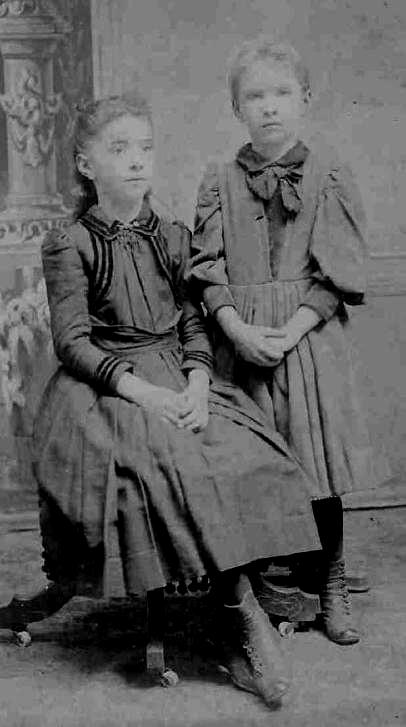
United States Boys' Clothes: Skirted Garments--Gender Conventions

Figure 1.--Both boys and girls wore dresses in the 19th century. One of our problems here is that so many old photographs are not identified. old photographs These siblings from St. Joseph, Michigan both wear dresses. The cabinet card is undated, but was probably taken about 1880. The children wear dresses, long stockings, and button-up leather shoes. The photographer is Hughson & Son. The children are unidentified, but the younger child looks like a boyakthiugh we are not all all sure. The short hair is a clue, especially because the older sister has longer hair, albeit swept back, Also notice the floppy boy which was more common for boys. Other than that we do not see any features of these dresses that would suggest gender.
|
|
Both boys and girls wore skirted garments in America. The gender conventions varied for the different garments. There is a huge photographic record beginning in the mid-9th century which provides insights on shirted garments and the gender conventions. The major problem in assessing the record is that usually the children are not identified. Gender can often be assessed even when the children are not identified, but in many instances we are left to wonder. While skirted garments are commonly thought a girls garments, in fact it was boys who wore all the different skirted garments. Girls did not. There were skirted garments that were only worn by boys. Both boys and girls wore dresses. American girls in the 19th and early-20th centuries commonly wore dressess, especially when dressing up. Many younger boys also wore them. Kilts were a different matter. Only boys wore kilts. This included all the various kilted garments, Highland kilts and kilt suits. Skirts are more mixed situation. Many younger boys wore skirts, mostly plaid skirts. Some were actually skirts with no kilt styling at all. Girls wore a range of skirts, including plaid skirts. We suspect that girls wore skirts more commonly than suggested in the photographic record, but this needs to be confirmed. It is likely that when girls dressed for a formal portait that they were more likely to wear aress than a skirt. Tunics were another garment for boys. We have seen girls wearing dresses thank look like skirts. And an girk may have worn an older brother's hand-me down tunic, but the vast majority of tunic images show boys wearing them. This can often be determined because boys commonly wore tunics with bloomer knickers that were often mean to show beneath the hem of the tunuc. Somocks were not very common in America for boys or girls. Pinafores on the other hand were very common, especially for girls of all ages. Some boys also wore them.
Both boys and girls wore skirted garments in America. The gender conventions varied for the different garments. There is a huge photographic record beginning in the mid-19th century which provides insights on shirted garments and the gender conventions ibvolved. This includes all the different skirted garments. The major problem in assessing the record is that usually the children are not identified. Gender can often be assessed even when the children are not identified, but in many instances we are left to wonder.
Specific Garments
While skirted garments are commonly thought to be a girls garments, in fact it was boys who wore all the different skirted garments. Girls did not. There were skirted garments that were only worn by boys. Both boys and girls wore dresses. American girls in the 19th and early-20th centuries commonly wore dressess, especially when dressing up. Many younger boys also wore them. Kilts were a different matter. Only boys wore kilts. This included all the various kilted garments, Highland kilts and kilt suits. Skirts are more mixed situation. Many younger boys wore skirts, mostly plaid skirts. Some were actually skirts with no kilt styling at all. Girls wore a range of skirts, including plaid skirts. We suspect that girls wore skirts more commonly than suggested in the photographic record, but this needs to be confirmed. It is likely that when girls dressed for a formal portait that they were more likely to wear aress than a skirt. Tunics were another garment for boys. We have seen girls wearing dresses thank look like skirts. And a girl may have worn an older brother's hand-me down tunic, but the vast majority of tunic images show boys wearing them. This can often be determined because boys commonly wore tunics with bloomer knickers that were often mean to show beneath the hem of the tunuc. Smocks were not very common in America for boys or girls. Pinafores on the other hand were very common, especially for girls of all ages. Some boys also wore them.
Age Trends
Unfortunately most of the images we have found with children wearing dresses do not identify them. There are images that are carefully ientified, usually on the back. But most of these old portraits are not identified.
Often they are clearly girls. You can't be absolutely sure, but we think it is fairly same to think that most of the children are clearly girls. But they almost certinly include some girls. We will archive some of these image here with what we can make out. It is of course impossibe to determine gender with any certainty when the child is not identified. There are, however, some indicators that are very useful in assessing gender. We invite readers to comment if they see anything in the images that needs to be mentioned.
HBC

Navigate the Boys' Historical Clothing Web Site:
[Return to the Main U.S. skirted garment page]
[Return to the Main U.S. garment page]
[Introduction]
[Activities]
[Biographies]
[Chronology]
[Clothing styles]
[Countries]
[Topics]
[Bibliographies]
[Contributions]
[FAQs]
[Glossaries]
[Images]
[Links]
[Registration]
[Tools]
[Boys' Clothing Home]
Created: 2:31 AM 3/29/2009
Last updated: 12:20 PM 6/7/2017



